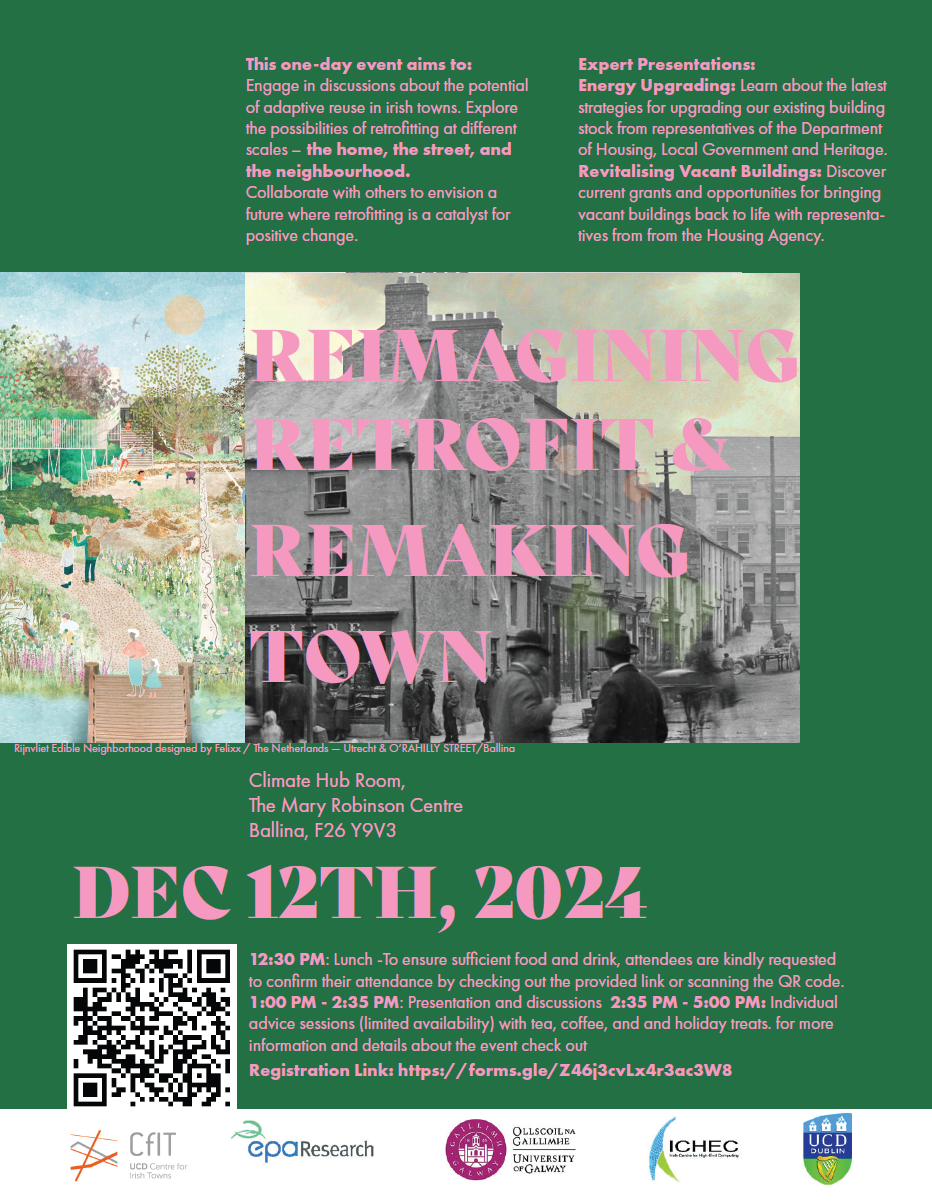
Project Start Date
31st Mar 2023
Project End Date
29th Mar 2025
TREBUChEt
Town Revitalisation through the Integration of Vacant Buildings into the Circular Economy
TREBUChEt is a two-year collaborative project between ICHEC (Liam Heaphy, Paul Nolan) and UCD (Oliver Kinnane, Philip Crowe, Ciara Reddy), funded under the EPA Research Programme 2021-2030 and co-funded by the Department of Food, Agriculture and the Marine. The EPA Research Programme is a Government of Ireland initiative funded by the Department of the Environment, Climate and Communications.
This project advances the analysis of the costs and barriers to adaptive reuse of buildings by including embodied emissions and life cycle analysis into cost-benefit analysis, while also connecting to strategic initiatives to reinvigorate rural villages and towns. It extends the discussion on end-of-life and upcycling in life-cycle analysis to expand into wholesale reuse of existing buildings, relevant for Ireland with its relatively high rate of vacancy (overall rate of 7.8% in the 2022 Census) and dereliction in urban centres of all scales.

Figure 1: Examples of vacant buildings in Counties Waterford and Tipperary.
TREBUChEt therefore builds on the principle that the most sustainable building is frequently the one that is already in existence, and that to ensure our settlements are sustainable, socially and environmentally, we need to avoid lock-in to carbon intensive forms of urban development by ensuring that the urban nuclei of existing towns and rural villages are utilised to their full potential. Therefore, to the extent that this underutilised resource can support the larger overall construction volumes required, we can better support broader objectives of carbon reduction, urban revitalisation, and safeguard Ireland’s built environment heritage for future generations.
Concept
Construction is resource intensive, consuming vast amounts of natural resources and energy. It also creates massive waste when buildings are part or wholly replaced and when this material is either downcycled (broken down and converted to lower value material) or discarded as general waste (Eberhardt, Birgisdottir, and Birkved 2019). This linear process of construction, use, and destruction, is giving way to the ‘circular economy’ with its focus on reduce, reuse, and recycle. This largely takes the form of integrating life cycle analysis of buildings into the construction process through designing buildings in a more modular form with greater potential for reuse when needs and functions change over time (Munaro, Tavares, and Bragança 2020).
Certification standards such as BREEAM (Building Research Establishment in the UK) and LEED (US Green Building Council) have long sought to incorporate carbon emissions into design, construction, and usage of buildings, while later standards such as AdaptSTAR have focussed more specifically on building reuse and designing future buildings for greater modularity and adaptability (Conejos, Langston, and Smith 2013). Correspondingly, research in the circular economy has focussed more on certification and design of building components, and the buildings themselves, than on decisions on whether or not to build in the first place when so many reusable building structures already exist in priority locations.
The IPCC’s Sixth Assessment Report (AR6) on Climate Change places a new emphasis on cultural heritage, comprising both material and intangible culture. However, they surmise that much official attention is on standout discrete sites (IPCC AR6 WGII 2022, 56), such as those covered by the Office of Public Works in Ireland and forming part of the corresponding sectoral report for adaptation. In order to safeguard historical buildings, the IPCC found that “the efficacy of adaptation of historic buildings can be increased through increased and stable funding, incentives, stakeholder engagement, and legal and political frameworks”. When allied to the finding in WGIII (mitigation) that it is in the retrofitting of old buildings that developed countries can make the greatest carbon savings (IPCC AR6 WGIII SPM 2022, 41), it follows that a developed country like Ireland should address existing building stock as a priority. In this sense, calculation of carbon savings adds a new dimension when incentivising the adaptive reuse of existing, and frequently vacant, town and village buildings.

Figure 2: Scope of the Life Cycle Analysis of buildings following the CEN TC350 standards (European Commission. Joint Research Centre. 2018)
Adaptive reuse (B1 to B5 in Figure 2) will play a central role alongside the work of the construction sector and the Irish Green Building Council’s work to make the maximum carbon savings on new builds.
Objectives
- Provide a methodology for evaluating the carbon savings of adapting buildings in town centres, using a representative typology based on the Town Centre Living Initiative report and in conjunction with the Heritage Council’s Collaborative Town Centre Health Check Programme.
- Evaluate how these carbon savings can be priced into cost-benefit analyses of adaptive reuse versus new build across a range of scenarios for the case study buildings and locations.
- Analyse the climate-proofing potential of these buildings in terms of vulnerability to extreme weather events, energy performance.
- Survey existing policy frameworks and incentives for building reuse and how embodied emissions could be incorporated and costed into planning and construction certifications.
- Provide a roadmap and toolkit for integrating heritage and town buildings into the circular economy, evaluating the relative contribution of restoring vacant buildings versus other circular economy measures. This will support the Heritage Council’s goal to “propose policies for adaptive re-use in order to mitigate the carbon impact of land use” (p.32).
- Provide guidance, services, and training in collaboration with the Heritage Council for bodies responsible for town centre renewal, including national government (e.g. DRCD, DAFM) and local authorities, the Heritage Council, IGBC, and SPAB Ireland.
Policy Relevance
This project makes a strategic contribution to recent initiatives to bring back town centre living by comparing the carbon costs of new build versus restoration, through a whole life carbon methodology conceptualised in the EC Level(s) framework and practiced by the Building in a Climate Emergency Research (BIACE) Group at UCD. The project builds on the Town Centre Living Initiative pilot scheme (DRCD 2020) (TLCI, Oct 2018 – Feb 2020), which evaluated the potential to restore town buildings in six Irish towns through comparing the adaptive reuse of buildings in case study areas within each town versus their equivalent as new builds (DRCD 2020). It reported that, in many cases, the “cost of refurbishing a building would be more than the value of the completed building” (DRCD 2020, p. 42), which along with insufficient resources to find and implement design solutions, and obtaining planning consent for the same, were identified as barriers.
The project is timed to coincide with the Collaborative Town Centre Health Check Programme led by the Heritage Council. This programme has 15 towns actively participating and over 40 further towns with an expressed interest in adhesion. Among other indices of vitality, the programme considers vacant town buildings and how they can be restored to occupancy. This research also complements the work of the Irish Green Building Council, whose methodologies and resources for carbon costing new builds is playing a central role in embedding embodied emissions into methodological frameworks and policy.
Outputs and Events
Workshop in Ballina, 12th December 2024
TREBUChEt is running a workshop in Ballina on the 12th December to talk about the challenges of restoring vacant properties to use and the benefits of overcoming them.

Report on Vacant and Derelict Properties
Our first report from TREBUChEt is a study of vacant and derelict building typologies in smaller Irish towns (i.e. < 50,000 inhabitants). It contains, firstly, exploration of a random sample of vacant and derelict buildings in Irish towns, and secondly, an analysis of the spatial geography of clusters of vacant and derelict buildings. This leads to an introduction to our case study towns of Tipperary, Monaghan, and Ballina (Co. Mayo).
Our random sample of 100 buildings from GeoDirectory shows a bias of vacancy towards town terraced buildings, which range greatly in style from vernacular shopfronts to more classical Georgian residences. One third of the vacant buildings from our sample were located in clusters of vacant and derelict buildings. This phenomenon was further studied through using GeoDirectory to identify clusters at the national scale in towns. We find that vacant/derelict town buildings are, on average, 200m closer to the centre point of settlements as compared to the general population of buildings, while clusters of vacant/derelict buildings are 350m closer to the centre point. The further propensity of vacancy and dereliction to be manifest at the level of town centre blocks or streets supports broader district-scale responses to town vacancy.
References
Conejos, Sheila, Craig Langston, and Jim Smith. 2013. “AdaptSTAR Model: A Climate-Friendly Strategy to Promote Built Environment Sustainability.” Habitat International 37 (January): 95–103. https://doi.org/10.1016/j.habitatint.2011.12.003.
DRCD. 2020. “The Town Centre Living Initiative Six Pilot Towns: Synthesis Report.” https://www.gov.ie/en/publication/86215-the-town-centre-living-initiative/.
Eberhardt, Leonora Charlotte Malabi, Harpa Birgisdottir, and Morten Birkved. 2019. “Potential of Circular Economy in Sustainable Buildings.” IOP Conference Series: Materials Science and Engineering 471 (February): 092051. https://doi.org/10.1088/1757-899X/471/9/092051.
European Commission. Joint Research Centre. 2018. Model for Life Cycle Assessment (LCA) of Buildings. LU: Publications Office. https://data.europa.eu/doi/10.2760/10016.
IPCC AR6 WGII. 2022. “AR6 Climate Change 2022: Impacts, Adaptation and Vulnerability — IPCC.” https://www.ipcc.ch/report/sixth-assessment-report-working-group-ii/.
IPCC AR6 WGIII SPM. 2022. “Climate Change 2022: Mitigation of Climate Change.” Intergovermental Panel on Climate Change. https://www.ipcc.ch/report/ar6/wg3/.
Munaro, Mayara Regina, Sérgio Fernando Tavares, and Luís Bragança. 2020. “Towards Circular and More Sustainable Buildings: A Systematic Literature Review on the Circular Economy in the Built Environment.” Journal of Cleaner Production 260 (July): 121134. https://doi.org/10.1016/j.jclepro.2020.121134.








